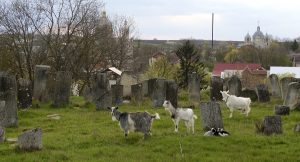![]() Ця сторінка також доступна українською.
Ця сторінка також доступна українською.
Introduction

Goats keeping grass and shrubs controlled in the Jewish cemetery of Tovste (Ternopil oblast).
Photo © RJH.
Topics in sustainability which are applicable to the preservation of Jewish burial sites in western Ukraine are many and varied, including conservation of the objects within a cemetery and the landscape itself (as well as minimizing the impact of conservation activities on the surrounding environment), planning for the evolution of tasks and budgets over the long term, and management of site and feature risk associated with political, economic, and climate changes. These are active verbs (conserving, planning, managing) which highlight that sustaining is not passive; for best effect, it should be incorporated into project concepts, both overall and for individual project components.
Most of the available references on heritage sustaining are aimed at national and local governments, presumed to be the stewards of cultural heritage in much of Europe and the world. However, the guidance, information, and data provided in many of these references can be partially or fully adapted to the provisional shared responsibility and activism of typical Jewish heritage projects in western Ukraine.
A few of the listed references are highlighted with brief summaries in the first section below, “key references”. Other useful resources on this subject may be found in the sections on regional and international experts, and on technical tools, methods, and data. Except where noted otherwise, all references listed here are in English.
Key References
Managing Change: Sustainable Approaches to the Conservation of the Built Environment; Jeanne Marie Teutonico and Frank Matero, eds.; Getty Conservation Institute; 2001. Free e-book available.
Assembled as the proceedings of an ICOMOS international symposium in partnership with the Getty Conservation Institute, the text includes articles in three parts which cover thinking, framing, and practicing sustainability. Thus the text and its diverse expert authors can help new project leaders to conceptualize the relationship between heritage conservation and sustainability, to develop approaches for managing change in the face of internal and external forces, and to apply methods and data to materials, processes, systems, and sites. Although none of the case studies presented by the authors specifically address cemeteries, sections on archaeological and agricultural sites relate to landscape concerns, and sections on building conservation relate to headstone and monument materials and construction. The first part of the text, on concepts, provides key terms and principles for integrating sustainability thinking into all conservation projects.
Printed and Electronic Books
- Managing Change: Sustainable Approaches to the Conservation of the Built Environment; Jeanne Marie Teutonico and Frank Matero, eds.; Getty Conservation Institute; 2001. Free e-book available.
- Routledge Companion to Global Heritage Conservation; Vinayak Bharne and Trudi Sandmeier, eds.; Routledge, 2019.
- Collaborative Heritage Management; Gemma Tully and Mal Ridges, eds.; Gorgias, 2016.
- Managing Cultural Heritage: An International Research Perspective; Luca Zan, Sara Bonini Baraldi, et al.; Routledge, 2015.
- Cultural Heritage Management: A Global Perspective; Phyllis Mauch Messenger and George S. Smith, eds.; University Press of Florida, 2014.
- World Heritage and Sustainable Development: New Directions in World Heritage Management; Peter Bille Larsen and William Logan, eds.; Routledge, 2018.
- A bibliography of Cultural Heritage at risk: from preparedness to management; UNESCO-ICOMOS Documentation Centre, 2011.
- Jewish Cemeteries and Sustainable Protection: An ESJF Handbook of Sustainable Heritage Tourism; Philip Carmel et al.; ESJF European Jewish Cemeteries Initiative, 2020.
- Sustainable tourism, a selective bibliography; ICOMOS Documentation Centre, 2017.
- Perpetual Care: A Sustainable Approach to Restoring the Lost Landscapes of America’s Rural Cemeteries (MS thesis); Benjamin Gilbert Buckley; University of Pennsylvania Scholarly Commons, 2013.
Journal Articles, Reports, and Web Pages
- Climate Change and Landscape Preservation: A Twenty-First-Century Conundrum; Robert Z. Melnick; APT Bulletin, Volume XL Number 3-4, 2009; pp. 35-42.
- Values and Heritage Conservation: Research Report; Erica Avrami, Randall Mason, and Marta de la Torre, eds.; Getty Conservation Institute, 2000. Free download available.
- Why must culture be at the heart of sustainable urban development?; Nancy Duxbury, Jyoti Hosagrahar, and Jordi Pascual; Agenda 21 for Culture – Committee on culture of United Cities and Local Governments (UCLG); 2016. Free download available.
Videos
- The Cycle of Use, Neglect, and Renewal in Historic Cemeteries of Niagara, Ontario; NCPTT; YouTube, 2014.
- Disaster Preparedness and Response for Historic Cemeteries; Jason Church; NCPTT, YouTube, 2013.
